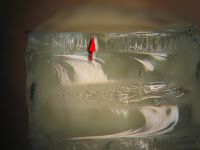California glass failure expert discusses the safety aspects of tempered glass;
Tempered glass is safer than standard (i.e. annealed) glass because “dices” into small pieces under certain failure modes. In reality, the overall glass failure is driven by residual stresses put into the glass by the tempering process. That is, tempered glass “destroys” itself. If the glass is impacted “side ways” the failed piece will break into safe small “diced” pieces. And this provides safety to one impacting the glass. However, there is the possibility that the glass can fail without a sideways impact. In this case, there is a possibility the glass sheet can fall intact. In addition, the edges of failed tempered glass are just as sharp as those created when annealed glass fails. The upper left photograph is of a piece of failed tempered glass that stayed “inter locked” after failure. The failure analysis photo on the upper right is an twenty times magnification photomicrograph of the one small piece of the failed tempered glass (arrow). The edges on this piece are not rounded. They have the same sharp edges associated with any failed piece of glass.
Bottom Line: Tempered glass is not always safe. The edges of the resulting pieces are sharp, and the glass pieces can remain interlocked in large sheets.






